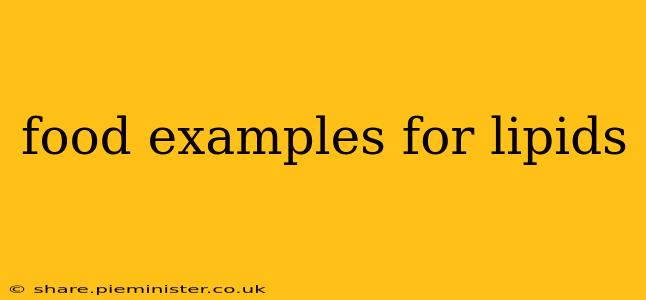Lipids are a crucial part of a healthy diet, playing vital roles in energy storage, cell structure, and hormone production. Understanding which foods are rich in lipids is key to maintaining a balanced and nutritious eating plan. This guide explores various food examples containing lipids, categorizing them for clarity and highlighting their unique benefits.
What are Lipids?
Before diving into specific food examples, let's briefly define lipids. Lipids are a diverse group of organic compounds that are insoluble in water but soluble in nonpolar solvents like ether and chloroform. They include fats, oils, waxes, and sterols. In the context of nutrition, we primarily focus on fats and oils, which are further categorized into saturated, unsaturated (monounsaturated and polyunsaturated), and trans fats.
Food Examples High in Saturated Fats
Saturated fats, generally solid at room temperature, should be consumed in moderation as excessive intake can raise LDL ("bad") cholesterol levels. However, they are a necessary part of a balanced diet. Examples include:
- Fatty Meats: Red meat (beef, lamb, pork), processed meats (sausages, bacon), and organ meats (liver, kidney) are rich sources of saturated fat.
- Full-Fat Dairy Products: Whole milk, butter, cheese (especially hard cheeses), and cream contain significant amounts of saturated fat.
- Coconut Oil: While a popular cooking oil, coconut oil is high in saturated fat.
- Palm Oil: Another commonly used cooking oil, palm oil is also rich in saturated fats.
Food Examples High in Unsaturated Fats
Unsaturated fats are generally liquid at room temperature and are considered healthier than saturated fats. They help lower LDL cholesterol and improve heart health. They are divided into monounsaturated and polyunsaturated fats:
Monounsaturated Fats
- Olive Oil: A cornerstone of the Mediterranean diet, olive oil is rich in monounsaturated fats, particularly oleic acid.
- Avocados: This creamy fruit is packed with monounsaturated fats and various nutrients.
- Nuts (Almonds, Cashews, Macadamia Nuts): These provide healthy monounsaturated fats along with protein and fiber.
- Seeds (Sesame, Sunflower): These small seeds are a good source of monounsaturated and polyunsaturated fats.
Polyunsaturated Fats
Polyunsaturated fats are further divided into omega-3 and omega-6 fatty acids. A balance between these two is important for optimal health.
- Omega-3 Fatty Acids:
- Fatty Fish (Salmon, Tuna, Mackerel): These are excellent sources of omega-3 fatty acids like EPA and DHA, crucial for brain health and heart function.
- Flaxseeds: These tiny seeds are rich in ALA, an omega-3 fatty acid that the body can convert (though not always efficiently) into EPA and DHA.
- Chia Seeds: Similar to flaxseeds, chia seeds contain ALA.
- Omega-6 Fatty Acids:
- Vegetable Oils (Soybean, Corn, Sunflower): These oils are high in omega-6 fatty acids, but it's essential to maintain a balanced intake of omega-3s and omega-6s.
- Nuts and Seeds (Various): Many nuts and seeds contain omega-6 fatty acids.
What are Trans Fats?
Trans fats are artificially created fats formed during a process called hydrogenation. They are associated with increased LDL cholesterol and decreased HDL ("good") cholesterol. Trans fats are generally considered unhealthy and should be avoided as much as possible. They are often found in:
- Processed Foods: Check food labels for partially hydrogenated oils, an indicator of trans fats.
- Fried Foods: Foods fried in partially hydrogenated oils will contain trans fats.
- Baked Goods: Some baked goods use partially hydrogenated oils in their recipes.
Are there any foods that contain only lipids?
No, foods are rarely comprised solely of lipids. While some foods are exceptionally high in lipids (like pure coconut oil), they usually contain other macronutrients like carbohydrates and proteins, and also various micronutrients (vitamins and minerals).
How much fat should I eat?
The recommended daily intake of fat varies depending on individual factors like age, activity level, and overall health goals. Consulting a registered dietitian or nutritionist can help determine your personal fat intake requirements. Remember to focus on consuming healthy unsaturated fats while limiting saturated and trans fats.
This comprehensive guide offers a detailed overview of various food sources rich in lipids, differentiating between the various types of fats and their effects on health. By understanding the different types of lipids and their food sources, you can make informed choices to build a balanced and nutritious diet.
